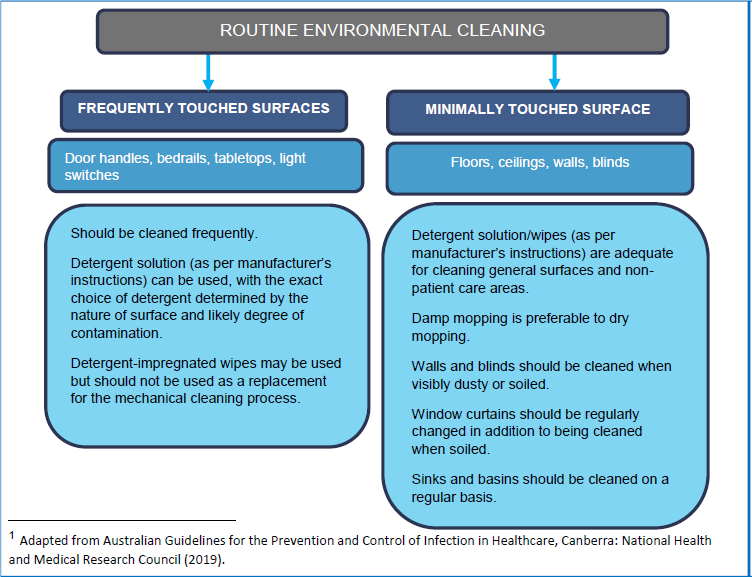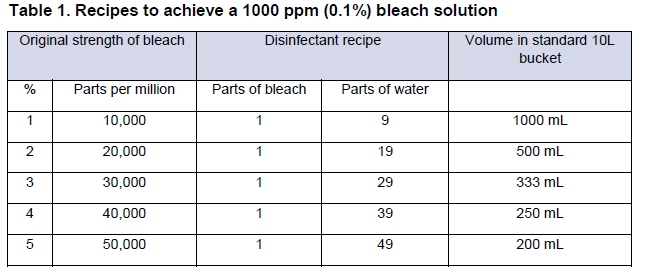- See Australian Government Department of Health; Environmental cleaning and disinfection protocols for health and residential care facilities
- Frequent, mechanical cleaning and disinfection is the best way to reduce transmission of diseases such as COVID through surfaces
- The length of time that COVID-19 can survive on surfaces varies depending on environmental factors, but current thought is it does not survive much longer than droplets drying out.
- Avoid touching face, especially mouth, eyes and nose while cleaning
- Cleaning staff should wear gloves for cleaning, including removal of trash, and should be thoroughly washed with soap and water afterwards.
The frequency of cleaning depends on the frequency surfaces are touched/exposed:

- Wipe down frequently touched surfaces and desks morning, midday and evening
Use disinfectant wipes in accordance with advice from the Centers for Disease Control and Prevention (US)
If wipes are not available use pre-mixed spray bottle with bleach
Prepare a bleach solution by mixing;
5 tablespoons (1/3 cup) bleach per 4.5L of water, or 4 teaspoons bleach per L of water
- Surfaces that are dirty can be washed with soap and water before being sanitized
- Extra wiping may be required between patients dependent on risk profiles
- Clean computers, computer accessories and screens, chairs and desks daily
- Clean minimally touched surfaces daily (floor, walls, windows etc.)
- For adequate disinfection use; alcohol solutions with at least 70% alcohol, diluted household bleach solutions and most household disinfectants.
“Diluted household bleach solutions can be used if appropriate for the surface. Follow manufacturer’s instructions for application and proper ventilation. Check to ensure the product is not past expiration date. Never mix household bleach with ammonia or any other cleaner. Unexpired household bleach will be effective against COVID-19 when properly diluted”
For soft surfaces such as curtains, carpets and couches remove any visible contamination and clean with cleansers appropriate for those surfaces. If the items can be laundered do so on the warmest appropriate water settings. Otherwise, use products with the EPA-approved emerging viral pathogens claim.
Keep in mind the hazards of using cleaning products and ensure proper ventilation, and use PPE for safety as required (e.g. safety glasses for bleach splash)
Bleach solution should be made up daily.
- If cleaning the area following a known COVID-19 case;
Wear full PPE including mask, gloves and eye protection.
Wait as long as practical before beginning cleaning to reduce transmission risk, if possible wait 24 hours.
Focus especially on frequently touched surfaces.
For more information on terminal cleaning see the Australian Government, Department of Health: Coronavirus disease (COVID-19) Environmental cleaning and disinfection protocols for health and residential care facilities.

References:
- Review of Optometric Business: Three actions to take to prepare your practice for coronavirus
- Centers for Disease Control and Prevention, US: Interim Infection Prevention and Control Recommendations for Patients with Suspected or Confirmed Coronavirus Disease 2019 (COVID-19) in Healthcare Settings
- Centers for Disease Control and Prevention, US: Isolation Precautions: Guideline for Isolation Precautions, Preventing transmission of infectious agents in healthcare settings
- Centers for Disease Control and Prevention, US: Environmental Cleaning and Disinfection Requirements
- Centers for Disease Control and Prevention, US: Interim Guidelines for Businesses and Employers to Plan and Respond to COVID-19
 View
View



